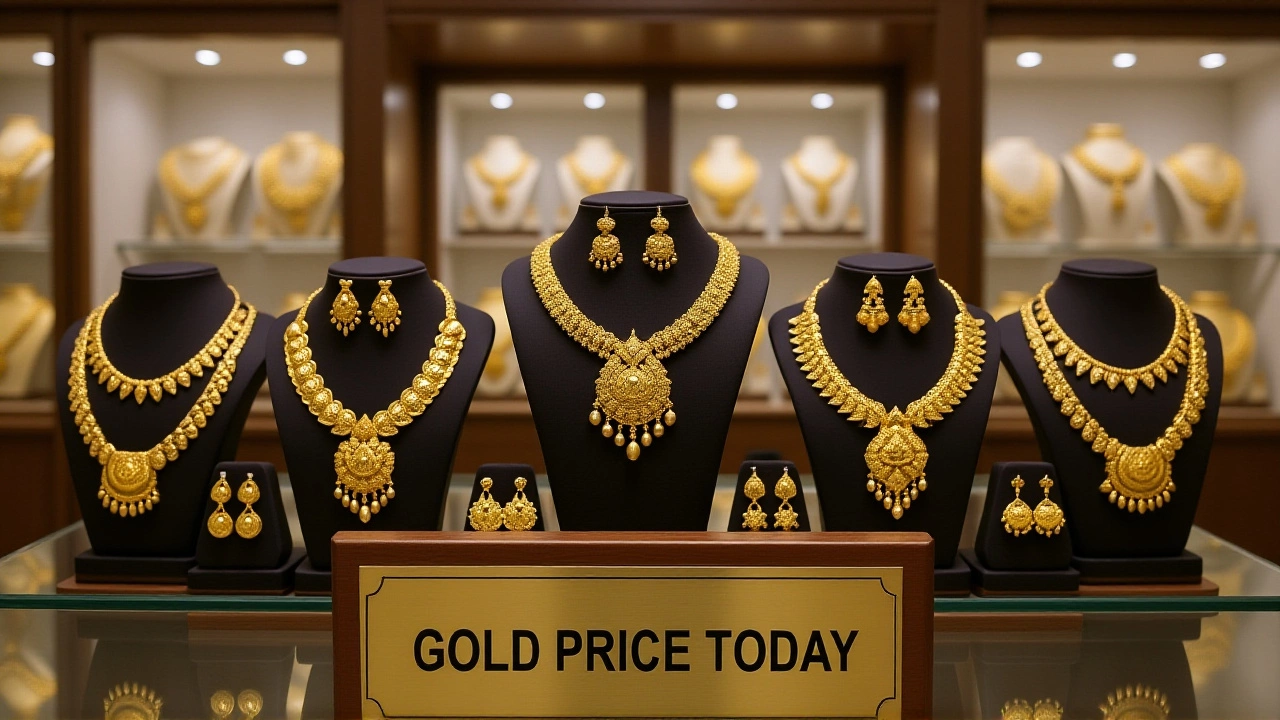
When Uttar Pradesh entered the final week before Dhanteras 2025Uttar Pradesh, gold prices surged past the ₹1.3 lakh mark for 10 g of 24‑carat gold. The jump wasn’t a flash‑in‑the‑pan; it capped a year‑long climb that began when 24‑carat gold was trading around ₹8,448 per gram in January.
Why the Spike Matters Right Now
On October 18, 2025, the state’s 22‑carat price settled at ₹12,095 per gram, translating to ₹1,20,950 for a 10‑gram bar. That was a touch lower than the previous day’s ₹1,22,700, but still a hefty sum for most families. BankBazaar.com highlighted that local taxes and transport costs keep Uttar Pradesh’s rates a few percent above metros such as Mumbai or Delhi.
Meanwhile, Goodreturns.in posted a nationwide 24‑carat rate of ₹13,086 per gram on the same day, confirming that the surge isn’t confined to one corner of the country. The platform also reminded readers that the Customs Department caps gold imports at 1 kg per shipment, a rule that tightens supply just when demand is roaring.
Seasonal Demand and the Dhanteras Effect
According to Times Now News, the festive buying frenzy that begins with Dhanteras traditionally pushes up gold prices by 5‑10 percent in a short window. This year, analysts say the effect is amplified by global risk‑off sentiment – investors are fleeing equities and seeking safe‑haven assets like gold.
"Festive buying and global risk support the floor," a senior analyst at Goodreturns, Anil Sharma, told reporters. "We’re seeing both retail demand from families buying jewellery and institutional buying from funds looking for a hedge. That dual pressure is what’s driving the record levels."
Year‑to‑Date Price Trajectory
A quick look at the numbers tells a clear story. In January, 24‑carat gold hovered around ₹8,448 per gram. By March it nudged up to ₹9,206, then to ₹9,804 in April. The pace slowed mid‑year – May and June stayed near ₹9,750 – before a decisive uptick in July (₹9,986) and August (₹10,206). September saw a 10.92 % jump, pushing the gram price to ₹11,744, and October kept the momentum, ending the month with a 9.75 % rise to the current ₹13,086.
For 22‑carat gold, the trajectory mirrors the higher‑purity metal: from ₹12,375 per gram on October 15 to ₹12,095 on the 18th, a modest dip that still represents a 54.7 % increase since the year's start.

Underlying Drivers – Beyond the Festival
Three forces converge to keep the gold market hot. First, domestic consumption spikes as families purchase jewellery for Diwali gifts. Second, the limited import quota from the Customs Department throttles fresh supply, especially as foreign mines face geopolitical constraints. Third, macro‑economic uncertainty – a wobbling rupee, rising oil prices, and tightening credit – pushes investors toward tangible assets.
“When global equities wobble, gold becomes the go‑to safe haven,” noted a market strategist at Moneycontrol.com. “The current rally isn’t just festive hype; it’s reinforced by the broader risk environment. If the rupee continues its slide, we could see 24‑carat breaching the ₹1.5 lakh per 10 g barrier before Diwali ends."
What This Means for Buyers and Investors
If you’re planning to buy jewellery for the holidays, the timing is crucial. Prices are already high, but they may climb another 5‑10 percent before the festival’s end. Some traders suggest buying in the early week of Dhanteras, when the initial surge settles, to avoid the last‑minute premium.
For investors, the surge adds a layer of complexity. Gold‑linked mutual funds and sovereign gold bonds still offer exposure without the storage headache, but they track spot prices and will reflect any further upside. On the other hand, holding physical gold now locks in a price that could appreciate if the rupee weakens further.
In short, the market is at a crossroads: festive demand, import limits, and global uncertainty are all pulling the price upward. Whether you’re a first‑time buyer or a seasoned investor, keeping an eye on daily rate changes from reliable trackers like BankBazaar.com and Goodreturns.in will be essential over the next few weeks.
Frequently Asked Questions
How will the ₹1.3 lakh price affect average households buying jewellery?
Most families allocate a modest budget for Dhanteras jewellery, often buying 5‑10 g pieces. At ₹1.3 lakh per 10 g, a 5‑g bar costs roughly ₹65,000, which is a noticeable jump from last year’s ₹50,000. Many shoppers may opt for 22‑carat alternatives or delay purchases until prices stabilise mid‑week.
What role does the Customs import limit play in the price rise?
India’s Customs Department caps gold imports at 1 kg per shipment, which tightens supply when global markets are volatile. With fewer kilograms entering the country, local dealers rely on existing stock, driving up wholesale rates that eventually filter to the consumer level.
Is the current surge purely seasonal, or will it continue after Diwali?
Seasonal buying provides the initial boost, but global risk factors—like a weakening rupee and geopolitical tensions—are sustaining the upward trend. Analysts at Moneycontrol.com expect prices to stay elevated for at least another month, potentially crossing the ₹1.5 lakh mark if macro‑economic pressures persist.
Should investors consider gold ETFs instead of physical gold right now?
Gold ETFs track the spot price without storage costs, making them a clean way to capture price movements. However, they mirror the same market dynamics, so any further price jump will be reflected in the ETF’s NAV. For those wary of price volatility, sovereign gold bonds offer a fixed‑rate component alongside the market‑linked value.
How do regional taxes affect the final price for buyers in Uttar Pradesh?
Uttar Pradesh imposes a 1 % GST on gold, plus state‑level sales tax that varies by district. Combined with transport levies, the effective cost can be 2‑3 % higher than the quoted spot rate. Buyers should ask retailers for a full‑breakdown to understand the net amount they’ll pay.
